
Midsummer – St John’s Eve
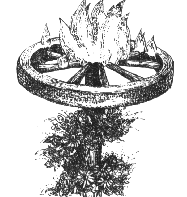 |
Spin earth! Tumble the shadows into dawn, The morning out of night; Spill stars across these skies And hide them with the suns. Teach me to turn My sullen sense toward marvel. – Raymond J. Baughan |
The earliest event that can be confidently said to have occurred on summer solstice happens to be one of the great triumphs of t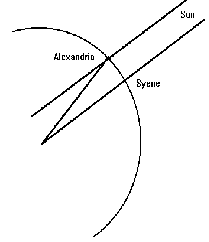 he rational mind. In 246 B.C., the Greek, Eratosthenes of Kyrene, was summoned from his homeland to undertake supervision of the great library at Alexandria. By chance he happened to be at Aswan (then Syrene) during the summer solstice. Looking into a well, he noted that the sun was absolutely, directly overhead. Yet, on the same day in Alexandria, (500 miles to the north) the sun cast shadows that inclined at an angle of about 7.2°. With these few rudimentary elements, Eratosthenes reasoned that the change in the angle of the shadows was brought about because he had moved about over the surface of the planet. Knowing that the earth was round, and further knowing the circumference of a circle to be 360°, this all-but forgotten genius calculated the circumference of the earth at roughly 25,000 miles. He was off by less than 1% — the actual figure is 24,901.55 miles.
he rational mind. In 246 B.C., the Greek, Eratosthenes of Kyrene, was summoned from his homeland to undertake supervision of the great library at Alexandria. By chance he happened to be at Aswan (then Syrene) during the summer solstice. Looking into a well, he noted that the sun was absolutely, directly overhead. Yet, on the same day in Alexandria, (500 miles to the north) the sun cast shadows that inclined at an angle of about 7.2°. With these few rudimentary elements, Eratosthenes reasoned that the change in the angle of the shadows was brought about because he had moved about over the surface of the planet. Knowing that the earth was round, and further knowing the circumference of a circle to be 360°, this all-but forgotten genius calculated the circumference of the earth at roughly 25,000 miles. He was off by less than 1% — the actual figure is 24,901.55 miles.
But celestial observation was the enduring preoccupation of Europe’s earliest inhabitants. Last year, the BBC reported on a startling discovery: among the elegant paintings of bulls, horses and antelope in France’s famous Lascaux caves, a 16,500 year 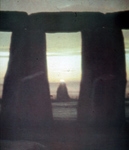 old star chart accurately depicts the Summer Triangle (Vega, Altari, Deneb) and the Pleiades as they surely looked when painted. Marching across the European landscape, scores of megalithic stone observatories have survived the vicissitudes of time, still serving to admit the first precious rays of either winter or summer solstice sun. The most famous of these was old when the Romans saw it, but even then, the Celts attributed construction of Stonehenge to an older race than they. Until the mid-1960s, archaeologists had no idea the stone circle was 5,000 years old (older than the Great Pyramid), but “radiocarbon dating and its astute employment by the British archaeologist Colin Renfrew forced them to abandon all the previous theories about how architectural advances had been exported to the barbaric northern lands from the Mediterranean and the Middle East.” (Atlantic Monthly, 1987) And while solstice may blanket an entire hemisphere at a time, the task of providing a receptacle for a single shaft of light to strike one specific spot on one particular day, year after year, is a task of mind-bending complexity: it requires precise knowledge, not just of the path of the sun and the moment of transit, but awareness of your exact position on the surface of the planet.
old star chart accurately depicts the Summer Triangle (Vega, Altari, Deneb) and the Pleiades as they surely looked when painted. Marching across the European landscape, scores of megalithic stone observatories have survived the vicissitudes of time, still serving to admit the first precious rays of either winter or summer solstice sun. The most famous of these was old when the Romans saw it, but even then, the Celts attributed construction of Stonehenge to an older race than they. Until the mid-1960s, archaeologists had no idea the stone circle was 5,000 years old (older than the Great Pyramid), but “radiocarbon dating and its astute employment by the British archaeologist Colin Renfrew forced them to abandon all the previous theories about how architectural advances had been exported to the barbaric northern lands from the Mediterranean and the Middle East.” (Atlantic Monthly, 1987) And while solstice may blanket an entire hemisphere at a time, the task of providing a receptacle for a single shaft of light to strike one specific spot on one particular day, year after year, is a task of mind-bending complexity: it requires precise knowledge, not just of the path of the sun and the moment of transit, but awareness of your exact position on the surface of the planet.
Arithmetic arcana was not the province of the peasantry, but it is striking that the continent over, the common folk of Europe’s various tribes marked summer solstice with identical habits and customs. “When we pass from the east to the west of Europe we still find the summer solstice celebrated with rites of the same general character. … Whatever their origin, they have prevailed all over this quarter of the globe, from Ireland on the west to Russia on the east, and from Norway and Sweden on the north to Spain and Greece on the south. According to a mediaeval writer, the three great features of the midsummer celebration were the bonfires, the procession with torches round the fields, and the custom of rolling a wheel.” (JG Frazer, The Golden Bough) Moreover, solstice was universally associated with some form of ritual bathing, of leaping over the dying bonfire, of driving cattle through smoke or ashes, and taking charred wood or ashes out to the tender crops in the fields. It is at first blush puzzling when every region of Europe (and sometimes even neighbouring hamlets and villages) accounts for a strictly uniform system of solstice observances with the most widely divergent explanations. But it may well imply that had they inherited their belief system intact, if by-then imperfectly understood, from the much older Indo-European founder race. For a contemporary example of this kind of regional construing; think of one in which a common denominator — say a kindly old gift giver — is given completely distinct characteristics and a new name (Father Christmas, Saint Nicholas, Pere Noel, Sinter Klaus) as he moves between cultures.
Whether or not the rolling of a lighted wheel downhill was meant to mimic the sun’s celestial estate, it’s impossible to imagine a more vivid depiction of the summer solstice. For it is now, at the height of its blazing powers, that the sun embarks on the long descent into the darkness and cold of winter. While we moderns consider solstice the “official” beginning of summer, it was not so in the old European reckoning. Their sun wheel marked out summer’s domain from May 1st through August 1st — making solstice the midpoint, or Midsummer. But given that solstice marks a great reversal in the sun’s career, their reading was actually the more accurate: our official beginning of summer is technically the beginning of the end of summer. Knowing that from this point the sun will traverse the sky at lower altitude on each subsequent day, our ancestors kindled fire and light for the failing life-bringer, to inspirit the sun to sustain crops, kine and kin over summer’s remainder. In simple terms, winter and summer solstice owe their very existence to the precession of the earth on its axis. In its unceasing journey, the earth presents either one or the other hemisphere to the sun. Twice a year it reaches a maximum degree of tilt, which makes the sun seem to pause briefly in the sky. Thus, during the southern hemisphere’s six month inclination, when that happens, we experience our winter solstice, or shortest day and longest night. Conversely, as our northern hemisphere is tilted sunward, summer solstice occurs on the date when the earth again reaches that maximum degree of tilt — or, our longest day and shortest night. The word solstice is Latin in origin, derived from sun (sol) standing still (sistere). The phenomenon of the sun seeming to stand still is most pronounced as you move into the extreme northern latitudes, where the midnight sun will ride, but never dip below the horizon.
 |
Summer seems to be the oldest word [of the four names of the seasons in English], traceable back to the proto-Indo-European, and used not only for half of the year but for a whole year, much as the day stands for the day-night cycle. – Guy Ottwell, The Astronomical Companion, 1986 |
Once, Midsummer’s approach was heralded by droves of young boys begging combustibles for the community bonfire, and, like our own trick or treat tradition: “threatening with evil consequences the curmudgeons who refused them a dole.” (Frazer) In a world where the nights were impenetrably black, it must have been an exciting occupation to know you were preparing a blaze that would leave the neighbouring villages gasping with admiration! Midsummer came at that blessed moment of respite between spring sowing and the heavy work of haymaking. Meanwhile, life was sweet as could be and moving toward fullness: safely delivered animal young frisked near mother; trees had shed blossom and fruit was developing; and the crops could almost be seen to grow. This was the occasion to give thanks while preparing against need, and perhaps, to find time for a little romance (for how could the marriage of trees and plants be fertile without the real union of human beings to show the way?)
As the Church appropriated and consecrated each of the pagan feasts in turn, it was inevitable that this unrestrained celebration of tumescence and fertility should be hastened into the fold: it is one of the oldest feasts introduced into both Greek and Latin liturgies to honour a saint. In keeping with the benevolent spirit of the season, the day settled on is one of the very few saint’s days to mark the anniversary of the birth, rather than the death, of its namesake, John the Baptist. While solstice can technically occur anywhere between June 20 – 26th, the Christian holy day is fixed at June 24th (although, in the old way, festivities are celebrated the night before, or St. John’s Eve). The precursor to Christ, it was John who baptized Jesus in the River Jordan — for which service Jesus referred to him as: “A burning and shining light.” Accordingly, the Church could in good conscience instruct congregations to light their Midsummer fires as they had always done — if only they would turn their thoughts to St. John instead of the sun. But churchmen would find this ancient root particularly difficult to eradicate, and so the holiday continues to flourish across Europe, disguised in a threadbare Christian cloak. In the Scandinavian countries solstice is an official public holiday, celebrated for convenience’ sake, on the Saturday nearest the 23rd. After the collapse of Soviet occupation, Estonia decriminalized bonfires and restored June 23rd as a national holiday. Alas, outside of Quebec, Midsummer has never really captured New World imaginations, and Hallowe’en very much remains our premier “pagan” feast.
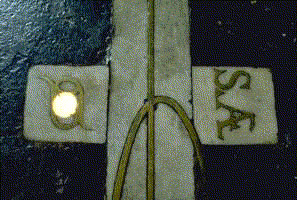
Meridian Room, Museo della Specola, Bologna, ca. 1741-2 – the gnomon “lights” the brass lamp |
It’s worth noting that in its urgent need to establish an unimpeachable date for Easter (the first Sunday after the first full moon after the vernal equinox) the Christian Church would in its turn adopt the “heathen” practice of building sacred solar instruments. In about 1460, Paolo Toscanella pierced the dome of the Florence cathedral to allow the summer solstice sun to shine upon a meridian line set into the floor of the nave. The trial of Galileo notwithstanding, this accelerated understanding of the universe would open new scientific frontiers and introduce innumerable changes to the calendar. By 1750, Catholic churches were unquestionably the finest solar observatories in the world. There are darkly conspiratorial intimations that remnants of heliocentrism and solar worship exist within the Church, but it is not our intention to impugn the Christian faith (certainly not with so many willing to do so) merely to cast a light on the long and complex evolution of our beliefs. |
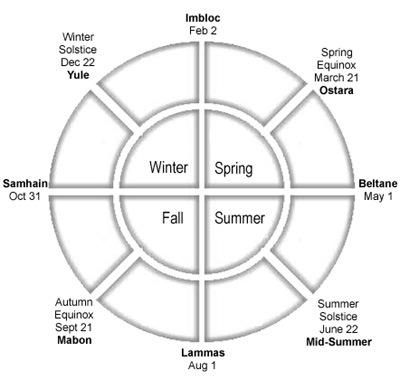
The old European wheel of the year
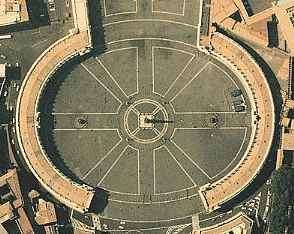
St. Peter’s Square, Rome
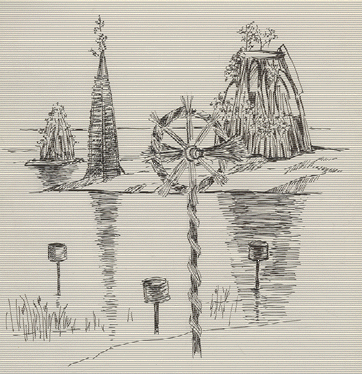
The nagging thought becomes irresistable when an inconsequential curiosity turns up over and over again, as is the case with the fern flower. All across the continent, there are ancient tales of the fern producing a magical flower that blooms only on Midsummer’s (St. John’s) Eve. The strange blossom variously bestows second sight, a vision of your future spouse, strength, moral fortitude, good fortune, or a brush with the little folk. In Russia, the summer solstice celebration is called Kupalo, and sure enough, the little flower is said to climb the stem of the fern to burst into bloom, on Kupalo’s Eve. Kupalo comes from the verb kupati, to bathe, and mass baths were taken on Midsummer morning.
Because the sun bathed by dipping into the waters on the horizon, some of its reflected glory might be realized by bathing in the light of the Midsummer dawn (not a bad idea for people who had spent the previous evening as they had — leaping over the dying flames of a bonfire and driving their livestock through it). It is interesting to note that the “winter disease” — Seasonal Affective Disorder — is a brought about by a disturbance within the pineal gland of the brain when elevated levels of seritonin trigger depression. The herbal remedy, St. John’s Wort (wort is the old Anglo-Saxon word for plant) has been a marketing bonanza, but research does seem to indicate that the Midsummer’s day namesake really does have a salubrious effect on mild cases of depression.
 In Athens, summer solstice was known as Plunteria Hiera, the festival of washing, or Ersephoria, Dew Carrying — a time when the ancient statue of Athena was taken to a sacred spring and purified in running water. Though this renewal was considered necessary for the goddess’ peace of mind, the absence of their protectoress made Athenians a little nervous.
In Athens, summer solstice was known as Plunteria Hiera, the festival of washing, or Ersephoria, Dew Carrying — a time when the ancient statue of Athena was taken to a sacred spring and purified in running water. Though this renewal was considered necessary for the goddess’ peace of mind, the absence of their protectoress made Athenians a little nervous.
How provident that the festival should occur when nature is at her most benign. (The original statue of Athena was nothing like the gaudy idol of the Parthenon, but rather smaller than life size and carved of olive wood). And, for the past year, two young girls (probably around seven years old — the Arrhephoroi, or “carriers of unspoken things”) would have lived with the goddess in the temple precincts, weaving a new robe, or peplos, for her. Only they and the Loutrides, or “bathers,” were permitted to gaze upon the image of the goddess unclothed. At nightfall, after the bathing, the small group made its way back to the sanctuary in torch-lit procession. There, unseen caskets of precious goods were exchanged, and new young girls were initiated into the service of the goddess for the coming year. These mysteries harkened back to the myth of Athena entrusting a sacred casket to the daughters of King Kekrops — two of whom disobeyed the goddess’ instructions, and peered inside the casket with fatal consequences. The other, faithful daughters were named Pandrosos, or “All Dew,” and Herse, or “Dew Carrying” (note the name of the festival). And it is these elements — of ritual bathing, and of the sacred nature of dew — that would survive Athena herself, turning up all over the continent. In Finland, Midsummer morning dew was collected from leaves and flowers for its magical healing properties. In Lithuania: “Before the sunrise on Solstice morning … people dragged sheets across the fields, collecting dew, which was then used for healing. … ‘Before the feast everybody went to the holy rivers and lakes, where they washed and bathed, hoping to stay young.” (romuva/usa”, Issue #4, 1991) In Portugal, “people say that St. John’s Eve [June 23] water possesses great healing power. Before dawn both cattle and young children are bathed in rivers or dew, to ensure health and strength.
Young girls and women like to wash their faces in spring water or early dew, so they will be lovely throughout the year.” (Festivals of Western Europe, Dorothy Gladys Spicer, H.W. Wilson, 1958, p. 168) Although it came to be more widely associated with May rituals; women all over Europe subscribed to the cosmetic possibilities of washing in the dew, and naturally so: agrarian people would surely recognize the properties of a substance that could miraculously “water” their crops, whether it rained or not. But it all leaves one with the curious, gnawing suspicion that some of these universals have to be holdovers of the older Indo-European tradition.
In the case of the wheel that figures so prominently at Midsummer — without a common source, isn’t it a very curious symbol to so preoccupy an entire continent? The old Roman solstice festival of Summanas honoured the aspect of Jupiter responsible for casting thunderbolts at night. Accordingly, 2 black wethers (castrated sheep) were sacrificed, but so were little cakes formed in the shape of wheels. In Scandinavian countries Midsummer festivities combine the elements of the wheel and the bonfire with the Maypole. There, it’s common practice to boat out on the lakes to view the burning spectacle on shore. As for the rolling of burning wheels, JG Frazer elaborates: “In Glamorgan [Wales] a cart-wheel swathed in straw used to be ignited and sent rolling down the hill. If it kept alight all the way down and blazed for a long time, an abundant harvest was expected. … In Poitou [France] also it used to be customary on the Eve of St. John to trundle a blazing wheel wrapt in straw over the fields to fertilize them. … At Lower Konz, a village situated on a hillside overlooking the Moselle, the midsummer festival used to be celebrated as follows.
A quantity of straw was collected on the top of the steep Stromberg Hill. Every inhabitant, or at least every householder, had to contribute his share of straw to the pile. At nightfall the whole male population, men and boys, mustered on the top of the hill; the women and girls were not allowed to join them, but had to take up their position at a certain spring half-way down the slope. On the summit stood a huge wheel completely encased in some of the straw which had been jointly contributed by the villagers; the rest of the straw was made into torches. From each side of the wheel the axle-tree projected about three feet, thus furnishing handles to the lads who were to guide it in its descent. The mayor of the neighbouring town of Sierck, who always received a basket of cherries for his services, gave the signal; a lighted torch was applied to the wheel, and as it burst into flame, two young fellows, strong-limbed and swift of foot, seized the handles and began running with it down the slope. A great shout went up. Every man and boy waved a blazing torch in the air, and took care to keep it alight so long as the wheel was trundling down the hill.
The great object of the young men who guided the wheel was to plunge it blazing into the water of the Moselle; but they rarely succeeded in their efforts, for the vineyards which cover the greater part of the declivity impeded their progress, and the wheel was often burned out before it reached the river. As it rolled past the women and girls at the spring, they raised cries of joy which were answered by the men on the top of the mountain; and the shouts were echoed by the inhabitants of neighbouring villages who watched the spectacle from their hills on the opposite bank of the Moselle. If the fiery wheel was successfully conveyed to the bank of the river and extinguished in the water, the people looked for an abundant vintage that year, and the inhabitants of Konz had the right to exact a waggon-load of white wine from the surrounding vineyards. On the other hand, they believed that, if they neglected to perform the ceremony, the cattle would be attacked by giddiness and convulsions and would dance in their stalls.” (Golden Bough, Ch. 62)
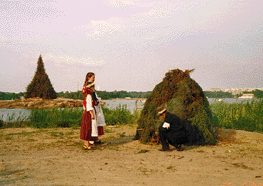
These cautionary Midsummer rituals — to safeguard the cattle — are especially poignant in light of the millions of animals so recently sacrificed on smoking pyres across Britain. Murrains, (highly infectious diseases among cattle) ravaged Europe from the time the Mongol horde embarked upon maurading excursions west, and, much like Bubonic plague, the devastating outbreaks would persist for centuries Bonfires were a universal feature of the summer solstice and one in which every community took part. Lady Wilde, the great chronicler of Irish folk lore, describes solstice as it was in 19th century Ireland: “The sacred fire was lighted with great ceremony on Midsummer Eve; and on that night all the people of the adjacent country kept fixed watch on the western promontory of Howth, and the moment the first flash was seen from that spot the fact of ignition was announced with wild cries and cheers repeated from village to village, when all the local fires began to blaze, and Ireland was circled by a cordon of flame rising up from every hill.
Then the dance and song began round every fire, and the wild hurrahs filled the air with the most frantic revelry. Many of these ancient customs are still continued, and the fires are still lighted on St. John’s Eve on every hill in Ireland. When the fire has burned down to a red glow the young men strip to the waist and leap over or through the flames; this is done backwards and forwards several times, and he who braves the greatest blaze is considered the victor over the powers of evil, and is greeted with tremendous applause. When the fire burns still lower the young girls leap the flame, and those who leap clean over three times back and forward will be certain of a speedy marriage and good luck in after-life, with many children.
The married women then walk through the lines of the burning embers; and when the fire is nearly burnt and trampled down, the yearling cattle are driven through the hot ashes, and their back is singed with a lighten hazel twig. These rods are kept safely afterwards, being considered of immense power to drive the cattle to and from the watering places. As the fire diminishes the shouting grows fainter, and the song and dance commence; while professional story-tellers narrate tales of fairy-land, or of the good old times long ago, when the kings and princes of Ireland dwelt amongst their own people, and there was food to eat and wine to drink for all comers to the feast at the king’s house. When the crowd at length separate, every one carries home a brand from the fire.” (Ancient Legends, Mystic Charms; and Superstitions of Ireland, 1887)
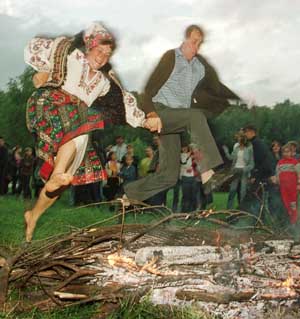
A couple leap the flames in Ukraine – wire photo, Midsummer 2000
In Lady Wilde’s version, young men leap the flames to flex their muscles a little, but elsewhere the self-same activity is associated with health, luck, fortune, or harvest: “as high as you leap the flames, so shall be the height of your crop of grain;” or, in the case of a couple, “to jump the flames and end still holding hands, yours will be a close and happy union.” Each region has again devised its own explanation for obeying what appears to be a common imperative. If a few Europeans indulged in the urge to leap over the dying flames of a bonfire, it might be dismissed as a bit of good fun — but when all do so, it again implies the unseen hand of a much older belief system at work.
Frazer notes that the Midsummer bonfire was prevalent even “among the Mohammedan peoples of North Africa, particularly in Morocco and Algeria; it is common both to the Berbers and to many of the Arabs or Arabic-speaking tribes. … They jump over the bonfires in the belief that this will preserve them in good health. … The celebration of a midsummer festival by Mohammedan peoples is particularly remarkable, because the Mohammedan calendar, being purely lunar and uncorrected by intercalation, necessarily takes no note of festivals which occupy fixed points in the solar year; all strictly Mohammedan feasts, being pinned to the moon, slide gradually with that luminary through the whole period of the earth’s revolution about the sun. This fact of itself seems to prove that among the Mohammedan peoples of Northern Africa, as among the Christian peoples of Europe, the midsummer festival is quite independent of the religion which the people publicly profess, and is a relic of a far older paganism.” But as Frazer must have known, North Africa was not always a uniformly Arabic region, it was long a European outpost, as some of the finest early examples of Roman mosaic attest.

It’s a season of wonders, and it’s fleeting — don’t miss it. Look at the spider’s web drenched in dew. Flee the city to see the stars spilled out across the Milky Way. If you can do so without spending the next day arranging bail, build a bonfire with loved ones — or soak bulrush “torches” in kerosene and let the poor kids live a little. If all else fails, rent British Lion’s lurid “Wicker Man” and live vicariously as deranged modern pagans practice ritual human sacrifice.
Solstice can occur day or night — anywhere from June 20 – 26. For the next few years, the moment of transit is as follows:
2001 JUN-21 @ 07:37
2002 JUN-21 @ 13:24
2003 JUN-21 @ 19:10
2004 JUN-21 @ 00:56
This, of course, is Greenwich Mean Time, now styled, “Universal Time.” (Presumably the name change will spare the feelings of third-rate astronomers and navigators). If you think you can possibly convert this to your local time without damaging anyone’s self-esteem, go ahead and subtract:
2.5 hours Nfld (daylight savings time)
3 hours Atlantic ”
4 hours Eastern ”
5 hours Central ”
6 hours Mountain ”
7 hours Pacific “
Thus, solstice occurs just about at dawn in Nfld. — 03:37 a.m. in Ontario, etc.
LINKS:
sun wheel ritual object – 1,500 BC – State Historical Museum, Stockholm
oldest sun wheel images?
Nathaniel Hawthorne – old ways with fire
Smithsonian’s monthly star chart (download, print, lay back and identify the constellations)
Riots at Stonehenge, 1999
The bonfire tradition in the Orkneys
Adventist “Catholicism as pagan sun-worship” (interesting, if a tad extreme)
Edmund Spenser’s 1595 poem Epithalamion, was written in celebration of his wedding, which coincided with summer solstice. While the poet in him may have been delighted by the symbolism of wedding taking place in the midst of all this erupting life and gaiety — the man was less pleased to think he would spend the shortest night of the year in his bridal chamber.
Ring ye the bels, ye yong men of the towne, And leave your wonted labors for this day: This day is holy; doe ye write it downe, That ye for ever it remember may. This day the sunne is in his chiefest hight, With Barnaby the bright, From whence declining daily by degrees, He somewhat loseth of his heat and light, When once the Crab behind his back he sees. But for this time it ill ordainèd was, To chose the longest day in all the yeare, And shortest night, when longest fitter weare: Yet never day so long, but late would passe. Ring ye the bels, to make it weare away, And bonefiers make all day; And daunce about them, and about them sing, That all the woods may answer, and your eccho ring.
